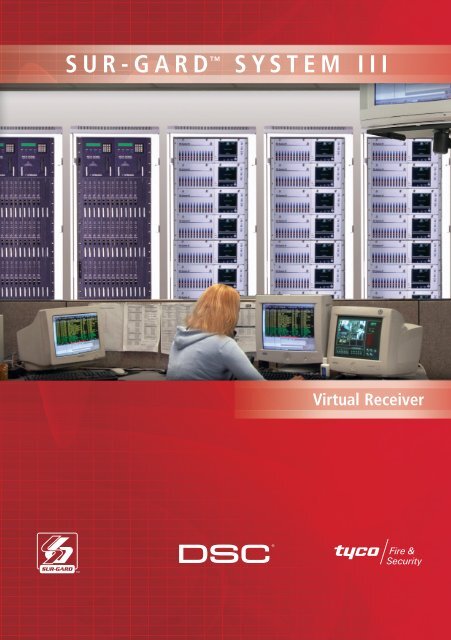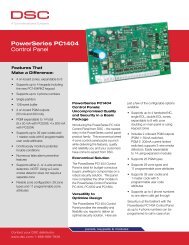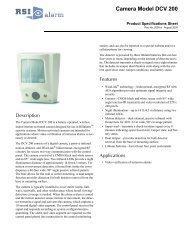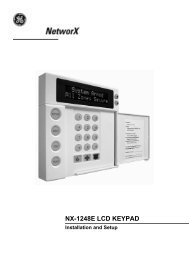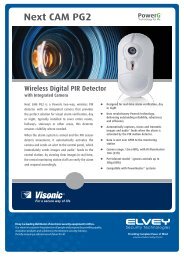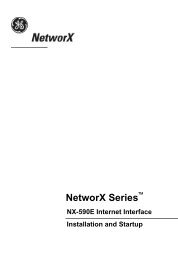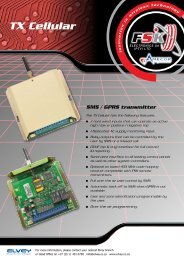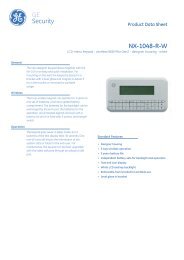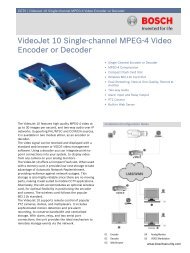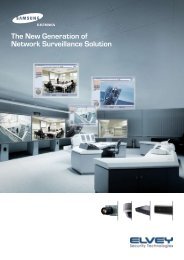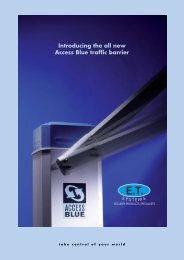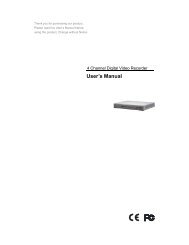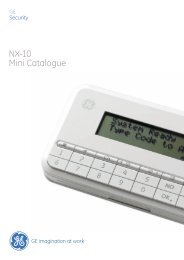SUR-GARD⢠SYSTEM III - DSC
SUR-GARD⢠SYSTEM III - DSC
SUR-GARD⢠SYSTEM III - DSC
You also want an ePaper? Increase the reach of your titles
YUMPU automatically turns print PDFs into web optimized ePapers that Google loves.
<strong>SUR</strong>-GARD <br />
<strong>SYSTEM</strong> <strong>III</strong><br />
Virtual Receiver
THE <strong>SUR</strong>-GARD <strong>SYSTEM</strong> <strong>III</strong><br />
VIRTUAL RECEIVER<br />
▲ ▲<br />
The industry’s fastest response time<br />
with patented Automatic Handshake<br />
Selection TM (AHS).<br />
Saves on phone costs and optimizes<br />
line card availability.<br />
▲ ▲ ▲<br />
Two 19-inch rack-mount cages are configured<br />
for auto-switching redundancy and provide<br />
double-safe back-up, zero downtime and<br />
UL/ULC approval.<br />
Secure, supervised Internet/network<br />
monitoring with same receiver.<br />
Mix-and-match 24 SG-DRL3 and<br />
SG-DRL3-IP line cards.*<br />
* SG-DRL3-IP network line cards provide 128-bit AES<br />
encryption, anti-hack design, compatibility with <strong>DSC</strong><br />
T-Link TL250 Internet Alarm Communicators, and are<br />
UL AA High-Line Security and ULC Level 3/4/5 listed,<br />
and FIPS/NIST listed.<br />
The Sur-Gard System <strong>III</strong> is a robust, 24-line virtual receiver* that<br />
can be expanded to accommodate 24 mix-and-match line cards<br />
(SG-DRL3 or SG-DRL3-IP). It resides in two 19-inch rack-mount<br />
cages and is configured for auto-switching redundancy. To aid in<br />
the identification of incoming calls is patented ANI and DNIS<br />
reception. ANI reception enables System <strong>III</strong> to identify the calling<br />
control panel; DNIS reception uses a numeric identifier<br />
programmed into System <strong>III</strong> line cards to identify and remember<br />
the profile (receiver type) of incoming calls. Once this information<br />
is known, patented Automatic Handshake Selection (AHS)<br />
technology instantaneously remembers the required handshake of<br />
the incoming control panel, eliminating the need for a handshake<br />
roll to be executed. This significantly decreases the online time of<br />
central monitoring stations, helping to save money on staffing and<br />
phone bills, and ensures that line cards are available to attend to<br />
incoming calls. And because more line cards are available, not as<br />
many are needed to manage caller demand.<br />
PRODUCT FEATURES:<br />
▼ ▼ ▼ ▼ ▼ ▼ ▼ ▼ ▼ ▼ ▼ ▼ ▼ ▼ ▼ ▼ ▼<br />
Maximizes use of all line cards<br />
Patented ANI and DNIS reception<br />
Patented Caller ID<br />
Patented Automatic Handshake Selection (AHS)<br />
Reduces phone charges<br />
Advanced two-way audio integration<br />
High-security network monitoring<br />
Fully “hot-swappable” modules<br />
Fewer line cards required<br />
Eliminates fixed-line hunt groups<br />
Integrated scheduled receiver line card testing<br />
Blocks unwanted communications<br />
Requires less physical space<br />
User-friendly configuration tools<br />
Upgradeable “flash” memory<br />
Automation output over TCP/IP or RS-232<br />
UL AA High-Line Security, ULC Level 3/4/5 listed,<br />
FM, CE, AUSTEL, CNC 55-3511<br />
* System lll is not exclusively a virtual receiver; it can be used<br />
with PSTN phone lines.
DESIGNED FOR EASY AND<br />
ECONOMICAL EXPANSION<br />
The 24-line System <strong>III</strong> virtual receiver is separated between two<br />
19-inch rack-mount cabinets. This allows for automatic switching<br />
redundancy of all internal components in the event of failure—if<br />
the primary CPM stops working, the secondary unit would<br />
instantaneously take over all duties until the problem is solved.<br />
The benefits of system integration include increased account<br />
volume and signal processing capabilities.<br />
System <strong>III</strong> can be configured to run one or a maximum of 24 line<br />
cards. A combination of phone line cards and network line cards<br />
can be used to create one integrated monitoring solution. A<br />
unique feature of the System <strong>III</strong> is an automation output over<br />
TCP/IP using a RS-232 serial output as a back-up.<br />
IMPROVED HANDLING OF<br />
INCOMING AND INTERNAL DATA<br />
System <strong>III</strong> features Digital Signal Processing (DSP) that increases<br />
the speed, accuracy and flexibility of each line card to allow the<br />
processing of a greater number of reporting formats.<br />
SELF DIAGNOSTICS DETECT<br />
AUTOMATION AND COMPONENT<br />
PROBLEMS INSTANTLY<br />
The System <strong>III</strong> Central Processing Module (CPM3) provides<br />
continual supervision of automation software to ensure<br />
automatic backup to a redundant port. For example, if the<br />
automation system goes off-line the CPM3 switches from the<br />
primary Ethernet port to a secondary, or to one of two serial<br />
ports, before going into manual mode. Additionally, the CPM3<br />
polls each line card to get consistent up-to-date information.<br />
SECURE NETWORK ALARM<br />
MONITORING<br />
SG-DRL3-IP line cards feature leading security measures such as<br />
128-bit AES encryption and an anti-hack design that isolates<br />
internal communications from external data transmissions. The<br />
line cards are FIPS/NIST and UL AA High-Line Security and<br />
ULC Level 3/4/5 listed.<br />
TELCO AND CE-IP CONNECTION<br />
SG-BP3X provides a PSTN phone line connection to the System <strong>III</strong><br />
via a 25-pin connector. The SG-BP3X-IP must be used for<br />
CE-approved applications when using IP communications.<br />
HOT-SWAPPABLE COMPONENTS<br />
Technicians can attend to any failure by replacing inactive<br />
components without any interruptions in service or having to<br />
power down the system.<br />
INTEGRATED LINE TESTING<br />
System <strong>III</strong> offers integrated end-to-end testing of up to 1,024<br />
telephone numbers. Line tests can be initiated on demand, or<br />
automatically using daily or weekly schedules. A unique test signal<br />
using SIA or Contact ID formats is programmed for each phone<br />
number and results are individually logged via Sur-Gard Console<br />
Software. System <strong>III</strong> can send test signals to other compatible<br />
receivers in a central monitoring station.
<strong>SUR</strong>-GARD <br />
<strong>SYSTEM</strong> <strong>III</strong><br />
P/N 30000027 R002 Printed in Canada<br />
DISASTER RECOVERY STRATEGY<br />
The use of an E1 circuit greatly improves disaster recovery capabilities. In the event of<br />
system failure, a primary central monitoring station can have communication to its<br />
System <strong>III</strong> receivers rerouted via the E1 circuit and directed to an alternate disaster<br />
recovery facility. This prevents any down time and ensures that activities can continue<br />
as normal.<br />
USER-FRIENDLY PROGRAMMING;<br />
FAST AND EASY UPGRADES<br />
System <strong>III</strong> can be programmed locally by referencing the unit’s menu-driven 1/4 VGA<br />
display or remotely over a network Ethernet connection using Sur-Gard Console<br />
Software. The software can also be used to upgrade the unit’s “flash” memory with<br />
new operating software without disrupting the activity of other components, handling<br />
hardware or pulling chips.<br />
<strong>SUR</strong>-GARD CONSOLE SOFTWARE<br />
Sur-Gard Console Software is an easy-to-use Windows-based utility used to<br />
configure the System <strong>III</strong> virtual receiver. The software connects via the receiver’s<br />
Ethernet port from any network computer providing a number of remote diagnostic<br />
tools such as communications debugging and real-time status of all subsystems.<br />
Other features include a “flash” memory upgrade utility, date and time<br />
synchronization, edit and archive configuration options, as well as a virtual event log.<br />
Ordering Information:<br />
SG-S<strong>III</strong>BASE (requires SG-DRL3s) . . . . . . . . . System <strong>III</strong> Basic Pack<br />
SG-S<strong>III</strong>EXP . . . . . . . . . . . . . . . . . . . . . . . . . . . . . . System <strong>III</strong> Expansion Pack<br />
SG-S<strong>III</strong>REDUN (requires SYST<strong>III</strong>EXP) . . . . . . . System <strong>III</strong> Redundancy Pack<br />
SG-DRL3 . . . . . . . . . . . . . . . . . . . . . . . . . . . . . . . . Virtual Line Card<br />
SG-DRL3-IP . . . . . . . . . . . . . . . . . . . . . . . . . . . . . Network Line Card<br />
SG-BP3X . . . . . . . . . . . . . . . . . . . . . . . . . . . . . . . . Centronics to RJ11 EXP<br />
SG-BP3X-IP . . . . . . . . . . . . . . . . . . . . . . . . . . . . . RJ45 Isolation Breakout<br />
Approval Listings:<br />
UL and ULC Listed for Fire and Burglary Alarm Central Station (Receiving Unit) Applications<br />
CE Compliant with EMC, R&TTE and Low Voltage Directives<br />
Australian Communications Authority (ACA) compliant (A-Tick mark)<br />
CNC 55--3511<br />
Specifications<br />
• Virtual receiver platform<br />
• Each SG-DRL3-IP line card supports up to 512<br />
supervised and up to 1,024 total T-Link TL250 accounts<br />
• Supports up to 24 line cards (IP or PSTN<br />
mix-and-match)<br />
• IP output to automation<br />
• Multi-format receiver<br />
• Patented Caller ID capability<br />
• Automatic Handshake Selection (AHS)<br />
• Patented virtual configurations<br />
• Advanced two-way audio integration<br />
• Supports ANI and DNIS C.L.A.S.S. signals<br />
• CPM3 central processing module<br />
• Universal power supply<br />
• Non-volatile RAM on each SG-DRL3 line card<br />
for programming and event buffer<br />
• “Flash” download software upgrades for SG-DRL3 line<br />
cards and the CPM3<br />
• DSP technology<br />
• Up to 64 different profiles used by each line card<br />
• Up to eight different handshakes per profile<br />
• Easy-to-read, menu-driven 1/4 VGA display<br />
• Hot-switching and swappable components for<br />
redundancy and central station certification<br />
• 256-event memory buffer on each individual line card<br />
• Real-time clock<br />
• One parallel printer port, two serial RS-232 ports<br />
and 10/100BaseT automation output<br />
• Continuous verification of computer/receiver links<br />
• Rack mount in standard 19-inch rack<br />
• Compatible with*: 10-40 baud, 3/1, 4/2 checksum, 3/1,<br />
4/1, 4/1 ext. 4/1 or 3/2, 4/2, Express, Acron, Adcor,<br />
Ademco Express, Ademco High Speed, Ademco Super<br />
Fast, BFSK, Contact ID, FBI Super Fast, ITI, Modem<br />
<strong>III</strong>a2, Modem II, IIA, IIB, IIE, Sescoa Super Speed, SIA<br />
20, SIA 8, SIA I, SIA II, SIA <strong>III</strong>, SK FSK 1, SK FSK 2,<br />
Sur-Gard 4/2, 4/3<br />
* A complete list of supported communication<br />
formats available upon request.<br />
Distributed by:<br />
For product information<br />
www.dsc.com<br />
Product specifications and availability subject to<br />
change without notice. Certain product names<br />
mentioned herein may be trade names and/or<br />
registered trademarks of other companies.<br />
©2005 2005•11


